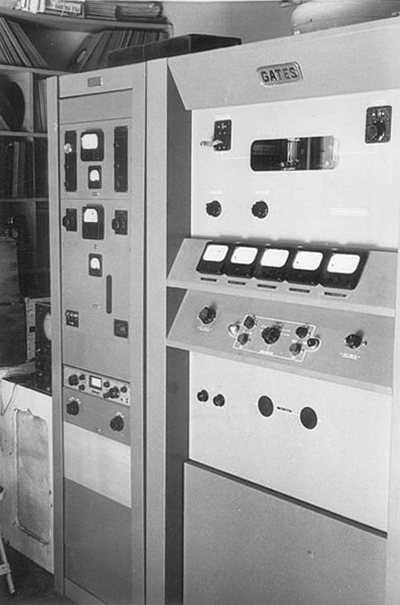
This Is Mostly Likely An AM Broadcast Transmitter.
Note What Looks Like An Universal Audio 175 Compressor/Limiter On The Left. |
Overview
- Azimuth
Azimuth is defined as the left/right movement of an audio head, as
seen from the front. This is designed to align all of the head gaps
exactly perpendicular to the tape. Typically, azimuth is performed in one
of two ways, the oscilloscope method, or the summing method. Both methods
are quite effective, and both have their advantages over the other.
- Oscilloscope Method
In this case, an oscilloscope is used in the X-Y mode. The two
scope inputs come from two tracks of the tape machine. The ideal tracks to
use should be as far apart as possible to allow for greatest resolution.
On a 24 track machine, however, typically tracks 2 and 23 are used since
the outside tracks (1 and 24) are susceptible to high frequency loss.
During playback, if the head is perfectly perpendicular to the tape, the
waveform seen on the scope will be a straight 45º diagonal line from lower
left to upper right. As azimuth is changed (and the phase difference
between the two tracks increases), the line will become an elongated oval,
and at 90º of phase difference, the waveform will be a circle. As phase
continues to increase, the circle will then start collapsing to an
elongated oval stretching from upper left, down to lower right. When the
two tracks in question are 180º apart, you will see a diagonal line from upper left to lower right.
When monitoring high frequencies, it is entirely possible to have
the head cranked to one side and actually have it appear in phase. This
results from the head being 360º out of phase and lining up on the wrong
node of the waveform. It is not possible, however, to be on the wrong node for both 1kHz and 10kHz at the same time. For this reason, you must always check azimuth
at 1kHz AND 10kHz. If you are on the wrong node for one of them (most
likely 10kHz), it will become apparent when the other is checked. Also, lower frequencies will appear as much more stable than higher
frequencies. On a well-maintained machine with good heads, even 10kHz will
appear solid. However, on a machine in need of a transport alignment, the
higher frequencies will be wobbling all over the place, and you must do
your best to find a happy medium.
- Summing Method
The summing method is a much simpler method of performing azimuth.
All tracks from the tape machine need to be summed to the mix buss, either
through channel faders or monitor faders. A fader level of -15db is a good
place to start for channel faders and the stereo buss. Then, azimuth is
adjusted while watching for the peak level on the stereo buss meters. The
actual level is not important, just where the peak is. However, in order
to have the most accurate reading, you should adjust the stereo buss fader
to show the highest level possible. Since all tracks on the head are being
summed together (not just 2 and 23), there will be only ONE position where
the azimuth will be correct (all tracks summing together and in phase), and
it is not possible to align the head on a wrong node of the waveform.
|